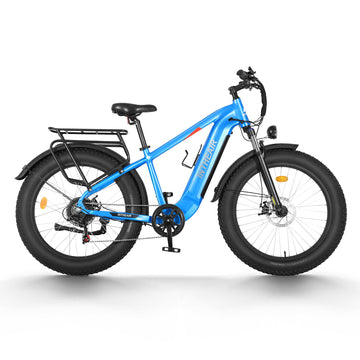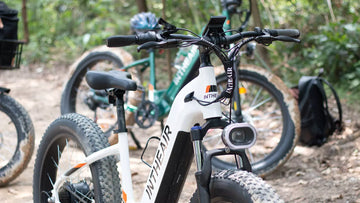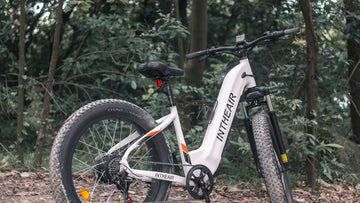How to Maintain E-Bike Brake Performance and Safety

The braking system of electric bike is one of the key points that need to be paid attention to when riding, especially compared with traditional bicycles, electric bikes have higher speed and power. Therefore, regular maintenance of electric bike brake system is very important for every vehicle. The braking system is usually has Hydraulic Brakes and Mechanical Disc Brakes. The braking principle and performance of both of them are very different, so the maintenance methods are also very different. Whether it is a mechanical brake system or a hydraulic brake system, how to maintenance is crucial. This article will introduce the tips for maintaining electric bike brakes, keep your brake system in good condition, and produce sensitive braking effect when encountering dangers or obstacles.
Differences between Mechanical Disc Brakes and Hydraulic Disc Brakes

The mechanical disc brake system generates braking force by engaging the brake pads with the disc rotor through the actuation of the brake cable. The brake lever transmits force by pulling the cable, tightly bringing the brake pads in contact with the disc rotor, thus braking the bicycle. On the other hand, the hydraulic disc brake system utilizes hydraulic pressure to transmit force. When the brake lever is pressed, hydraulic fluid transmits pressure in the system, pushing the brake pistons to engage the brake pads with the disc rotor, generating braking force.
Maintenance of Mechanical Disc Brake Systems
- Regularly check the brake pads:Brake pads are crucial components of the braking system, and their thickness can wear down during daily braking. It's important to frequently monitor the wear level of the brake pads and promptly replace them when their thickness falls below the safety standard to prevent brake failure.
- Adjust the brake cable tension: Understanding the principles of mechanical disc brakes, it's known that the tension of the brake cable directly affects the braking performance. Therefore, it's necessary to regularly adjust the brake cable tension to the appropriate level, avoiding overly loose or tight conditions that could impact the braking effectiveness.
- Clean the brake disc: If there is any dirt or debris on the brake disc, it will significantly affect the braking performance. Regularly cleaning the brake disc is an important step. Use a non-oil-based solvent and a clean cloth to wipe and remove dirt, impurities, and residues from the disc. However, avoid using cleaning agents containing alcohol or solvents as they can damage the disc.
- Inspect brake lines and exposed cables: Periodically check the brake lines for signs of wear, cracks, or damage. Ensure that the brake lines and cables are not frayed or deformed to prevent any adverse effects on the braking performance. If any issues are found, promptly replace the damaged components.
- Regularly lubricate mechanical components: Lubricating the brake lever, pistons, and brake linkage reduces friction, minimizes energy loss, and improves braking efficiency. It enhances the sensitivity and smoothness of mechanical components, resulting in improved brake response speed and accuracy. Regular lubrication also forms a protective layer on the metal components of the braking system, preventing corrosion from moisture and other factors.
- Avoid brake overheating: Continuous and prolonged braking can cause the brake disc to overheat. Excessive heat reduces the friction coefficient and diminishes braking effectiveness, potentially resulting in brake performance degradation or failure. To prevent this, avoid continuous long-duration braking, make moderate use of both front and rear brakes, and consider installing brake cooling systems or fans
Maintenance of Hydraulic Disc Brake Systems

-
Regularly check the brake fluid: Check the brake fluid level regularly and ensure it is within the normal range. If the fluid level is too low, add brake fluid promptly. Also, inspect the cleanliness of the brake fluid. The brake fluid should remain clean without impurities or contaminants. If the brake fluid appears dark or noticeably contaminated, it should be replaced promptly.
-
Inspect brake lines and connections: Check the brakeRegularly inspect the brake lines and hoses for wear and damage: Periodically check the brake lines and hoses for any noticeable wear, cracks, or damage. If any issues are found, replace the damaged components promptly.
-
Inspect brake pistons and piston seals: Check the cleanliness and smooth operation of the brake pistons. Regularly inspect the surface of the brake pistons for cleanliness, ensuring there are no dirt or deposits. Also, check the piston seals for any signs of wear or leaks. If any issues are detected, replace the seals as necessary.
-
Maintain cleanliness of the brake system: Use a non-oil-based solvent and a clean cloth to wipe the brake disc surface, removing oil, dirt, and residues. Regularly check the wear of the brake pads and replace them promptly if their thickness falls below the safety standard.
-
Avoid brake fluid overheating: Avoid continuous long-duration braking, which can lead to elevated temperatures of the brake system. Excessive heat can reduce braking efficiency. To prevent this, give the brake system cooling time and consider installing brake cooling systems or fans.
Differences between Mechanical Disc Brakes and Hydraulic Disc Brakes
Mechanical Disc Brake System
- Operated by pulling the brake cable to engage the brake pads with the disc rotor.
- Simple in design and maintenance.
- Provides moderate braking force.
- Requires regular adjustments to maintain optimal performance.
- Generally more affordable compared to hydraulic disc brakes.
Hydraulic Disc Brake System
- Operated by hydraulic pressure, using brake fluid to transmit force.
- Offers high braking force and excellent control.
- Requires less maintenance compared to mechanical disc brakes.
- Provides a more sensitive and responsive braking experience.
- More complex in design and installation.
- Generally higher in cost compared to mechanical disc brakes.
Conclusion
Proper maintenance of both mechanical and hydraulic disc brake systems is crucial for ensuring the safety and optimal performance of your electric bike . By following these maintenance tips, you can keep your braking system in excellent condition, allowing for responsive braking in dangerous or obstacle situations.



